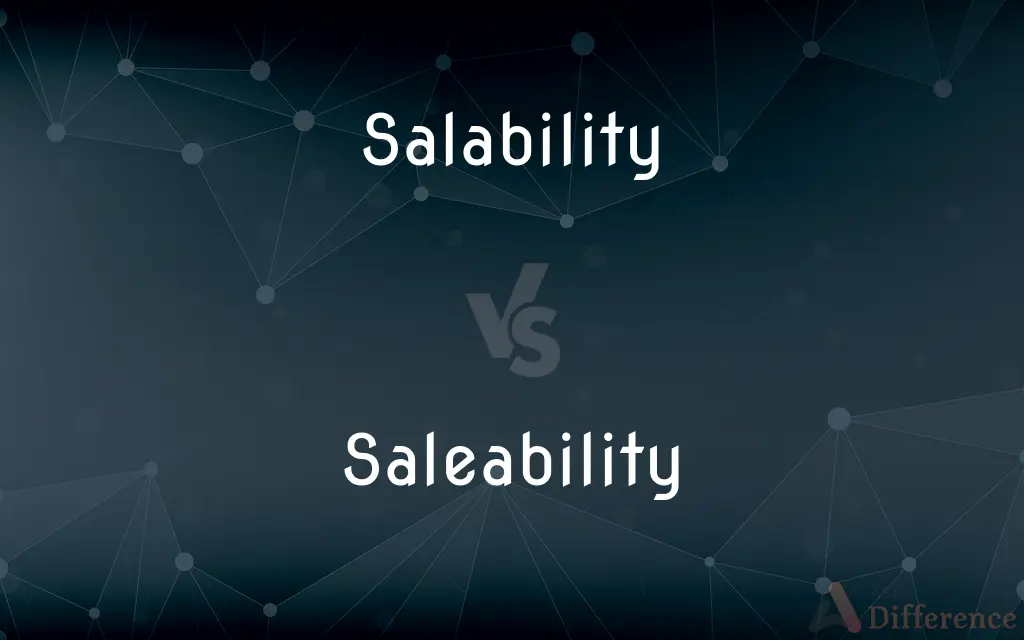Salability vs. Saleability — What's the Difference?
By Maham Liaqat & Urooj Arif — Updated on April 7, 2024
Salability and saleability both refer to the ease with which something can be sold, focusing on market appeal and demand. They are different spellings of the same concept, with no difference in meaning.

Difference Between Salability and Saleability
Table of Contents
ADVERTISEMENT
Key Differences
Salability and saleability are terms used to describe the ease or likelihood of an item, property, or service being sold, indicating its attractiveness to potential buyers. The choice between "salability" and "saleability" often comes down to regional spelling preferences, with both terms being used interchangeably across different English-speaking regions.
The concept of salability/saleability is crucial in various industries, such as real estate, retail, and digital marketplaces, where understanding what makes a product or service appealing to consumers can significantly impact sales strategies and pricing decisions. The terms encompass factors such as demand, condition, market trends, and pricing, which collectively determine how quickly and profitably something can be sold.
While "salability" is more commonly used in some regions, "saleability" might be preferred in others, but there is no distinction in their meanings. Both spellings are accepted and understood within business and marketing contexts to convey the same idea.
Factors influencing salability or saleability include the item's condition, its desirability in the current market, competitive pricing, and marketing efforts. These factors can vary greatly depending on the type of product or service, the target market, and economic conditions.
Understanding the salability or saleability of an item can help sellers optimize their sales approach, from pricing correctly to highlighting the most attractive features of what they're selling. This concept is a foundational element of commerce, affecting decisions from individual sales to corporate strategies.
ADVERTISEMENT
Comparison Chart
Definition
The ease with which something can be sold.
Identical to salability.
Regional Preference
Varies, with some regions preferring "salability."
Varies, with some regions preferring "saleability."
Factors Influenced
Demand, condition, market trends, pricing.
Identical to salability.
Industries Impacted
Real estate, retail, digital marketplaces.
Identical to salability.
Importance
Crucial for sales strategies and pricing decisions.
Identical to salability.
Compare with Definitions
Salability
Influence of condition on sales.
The car's salability was impacted by its mileage.
Saleability
Dependence on product appeal.
Innovative features boosted the gadget's saleability.
Salability
Ease of being sold due to demand.
The salability of waterfront properties remains high.
Saleability
Likelihood of being purchased.
The saleability of the novel increased with the author's popularity.
Salability
Role in pricing strategies.
Pricing too high can negatively affect a product's salability.
Saleability
Relation to economic conditions.
Economic downturns can challenge the saleability of luxury goods.
Salability
Importance in marketing efforts.
Effective advertising can enhance a product's salability.
Saleability
Significance of presentation.
Professional staging can significantly improve a home's saleability.
Salability
Impact of market trends.
Fashion trends greatly affect the salability of apparel.
Saleability
Effect of competitive pricing.
Saleability often hinges on how prices compare to competitors.
Salability
Offered or suitable for sale; marketable.
Saleability
Saleability (also called profitability) is a technical analysis term used to compare performances of different trading systems or different investments within one system. Note, it is not simply another word for profit.
Salability
The extent to which something can easily be sold
Saleability
The quality or state of being saleable.
Salability
The quality or condition of being salable; salableness.
Common Curiosities
What factors affect salability?
Factors include the item's condition, market demand, pricing, and effectiveness of marketing efforts.
Does saleability only apply to physical products?
No, saleability also applies to services, digital products, and intangible goods.
What does salability mean?
Salability refers to how easily a product or service can be sold, based on its appeal to potential buyers.
How can one improve the salability of a product?
Improving product quality, competitive pricing, appealing marketing, and aligning with market trends can enhance salability.
Is salability more important for certain types of products?
While important for all products, salability is particularly crucial for high-value items like real estate, where the sales process is more complex.
How do businesses measure salability?
Businesses may use market analysis, sales data, customer feedback, and competitive benchmarking to measure salability.
Can economic conditions influence saleability?
Absolutely, economic conditions greatly affect consumer spending habits and thereby influence saleability.
Can saleability change over time?
Yes, the saleability of a product or service can change due to market trends, consumer preferences, and economic conditions.
Are salability and saleability the same?
Yes, salability and saleability refer to the same concept and are used interchangeably.
Does branding affect salability?
Strong branding can significantly enhance the salability of a product by increasing its attractiveness and perceived value to consumers.
Why is understanding saleability important for sellers?
Understanding saleability helps sellers make informed decisions about pricing, marketing, and product development to maximize sales potential.
Is there a legal aspect to consider in salability?
Legal issues, such as compliance with regulations, can impact the salability of certain products, especially in industries like healthcare and food.
What role does customer perception play in salability?
Customer perception is key; a positive perception can enhance salability, while negative views can diminish it.
How does technology impact the salability of products?
Technology can improve salability through better production methods, online marketing, and digital sales platforms, making products more accessible to buyers.
Can too high a price affect saleability?
Yes, setting a price too high can deter potential buyers, negatively affecting a product's saleability.
Share Your Discovery

Previous Comparison
Mundanity vs. Mundaneness
Next Comparison
Abbreviation vs. InitialAuthor Spotlight
Written by
Maham LiaqatCo-written by
Urooj ArifUrooj is a skilled content writer at Ask Difference, known for her exceptional ability to simplify complex topics into engaging and informative content. With a passion for research and a flair for clear, concise writing, she consistently delivers articles that resonate with our diverse audience.














































